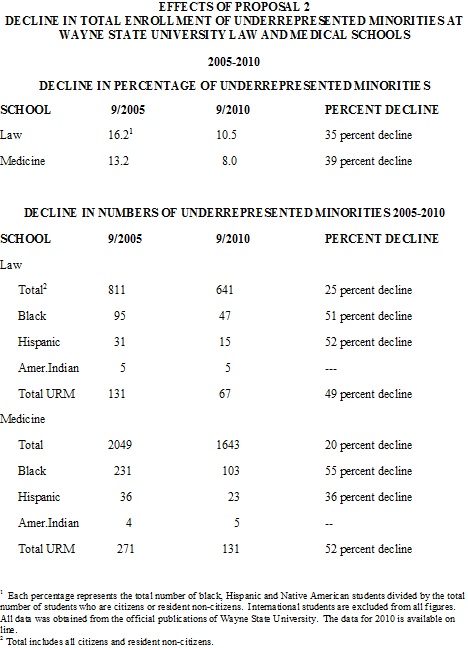 Excerpts From the Brief
Excerpts From the Brief
Yesterday, BAMN’s legal team at Scheff, Washington & Driver filed the legal brief in defense of our victory last summer to overturn Prop 2 and restore affirmative action in Michigan. The brief was a response to the attempt by the opponents of affirmative action (lead by Michigan’s Attorney General Bill Scheutte) to reverse our victory by requesting an “en banc” hearing by the full panel of the 6th Circuit Court of Appeals. The original ruling was decided by a three judge panel.
[editor’s note: subtitles added and legal citations and footnotes omitted for easier reading by the lay person – for full references see complete legal brief highlighted above]
Prop 2: Depriving Minorities of a Means to Win Equality
The AG’s rationales—which he derives from Connerly—… loudly repeat the promises of ending racial discrimination, but in fact they exclude black, Latino and Native American students from the universities. And they then assert that minorities should be denied any political means for winning departures from the grade-test score criteria because admissions should be governed by the “customary” standards of grades and test scores.
The plaintiffs ask this Court to strike down Proposal 2 because it will profoundly limit their rights and their opportunities. But much more is at stake. Slavery and de jure segregation only survived because the states deprived racial minorities of all political means to challenge inequality. In both cases, these actions crippled and disfigured the country and were finally overcome only by great convulsions. We should not again inflict such damage on the country or on the young people of all races who will soon inherit that country.
History of College Admissions in Michigan
In 1961, when the sons and daughters of the middle and working classes first entered college in large numbers, the university adopted for the first time and on an experimental basis standardized tests as a requirement for in-state applicants.
From the start, however, the Regents provided exceptions from the grade-test score standards in order to assure the admission of poorer students, rural students, veterans and many others.
In the 1960s, the emerging Civil Rights Movement protested that even with those exceptions, the new grade-test score system excluded almost all black and other minority applicants. Black students in particular pointed to the Law School which graduated 3,032 white law students—and eight black law students—during the entire decade of the 1960s. They pointed as well to the University’s famous College of Literature, Science and the Arts, where black students were only 3.5 percent of the total enrollment as late as 1970.
In 1970, the student Black Action Movement (BAM) led a campaign of political action, including a three-week strike, demanding change by the Regents. After intense negotiations, the Regents passed a resolution agreeing to consider race in order to reach a “goal” of 10 percent black students by 1973. The new policy ended de facto segregation, with black students increasing to 8 to 9 percent and Latino students moving to 4.7 percent.
Fourteenth Amendment Overrides “States’ Rights”
The AG claims that this Court should approve of Proposal 2 because Michigan voters adopted it in a referendum. But, of course, a state electorate cannot override the democratic mandate of the Fourteenth Amendment. Moreover, in this case, the decision to override Grutter was in reality a white majority voting to deny a black and Latino minority political rights and educational opportunities. A statistical study of the 2006 elections as a whole conducted for the major television networks demonstrated that it passed only because the two-to-one Yes votes among white voters overwhelmed the nine-to-one vote against Proposal 2 by the state’s black minority.
Phony “Merit System” for Minority Applicants Alone
The AG asserts that Michigan has a compelling interest in admissions by “merit,” by which he means “merit” as determined by the grade-test score system. But because universities have long granted exceptions from this system for many purposes, the AG has the impossible task of showing that the state has a compelling interest in assuring a “merit system” for minority applicants alone.
Even apart from the double-standard, the AG offers no proof that Michigan has a compelling interest in preventing the consideration of departures from this system. As shown by the historic experience both before and after affirmative action, the grade-test score criteria exclude large numbers of minority applicants. This is not an accident, for both of its key components—grades and test scores—incorporate and magnify inequality.
GPA/Test Score Criteria Incorporate Racial Bias
Three-quarters of Michigan’s black students attend segregated or intensely segregated primary or secondary schools. By any standard, these schools are not equal to those attended by almost all of the state’s white students. Moreover, for reasons set forth in the plaintiffs’ prior briefs, the pervasive segregation and inequality negatively affect the educational achievements of even those few minority students who are able to attend integrated schools. The adjusted grade point average reflects both the stability of the schools available and the type and quality of the courses that those schools offer—and minority applicants suffer sharp disadvantages on both counts.
The standardized tests place those students at a far greater disadvantage. In 2007, white students’ combined score on the SAT verbal and math sections was, respectively, 125, 208 and 292 points higher than the average score by students from Native American, Latino, and African-American backgrounds.
Some of the gap was caused by economic disadvantage. But Connerly, who was once a Regent of the University of California, testified that the UC’s studies revealed that black students from families in the highest one-fifth of income scored lower on average than white students from families in the lowest one-fifth of income.
Huge Test Score Gap Between Minorities and White Students With Equal Educational Achievements
Some of the gap reflects the educational disparities. But for some students, the tests produce gaps even though the students’ records show that they have equal educational achievements. Most famously, at the UC’s Boalt Hall Law School, the admission records revealed that black applicants scored on average nine points lower on the LSAT than white applicants with the same grade point average in the same major at the same undergraduate college.
Every expert—including those employed by the manufacturers of the test—agrees that test scores and the test score gaps do not reflect differences in “intelligence,” “aptitude,” or similar qualities. Even more clearly, test scores do not reveal commitment, industry, imagination, motivation, curiosity, or leadership. Among students deemed qualified for universities, differences in test scores and grade point averages do show a weak correlation with average first-year grades. But the significance of that correlation is itself suspect because first-year grades are affected by racial isolation and deficiencies in preparation—both of which can be overcome with time.
Low Predictive Value of Standardized Tests
The low predictive value of the tests is constantly revealed. The University of Texas, for example, recently discovered that students admitted from small rural and large urban high schools under the top “ten percent” plan achieved higher grades at UT than students admitted under other criteria even though the ten percent group had significantly lower average test scores.
…the grade-test score criteria incorporate and exaggerate de facto inequality in the primary and secondary schools and in the tests themselves. Because, however, there are no commonly-accepted alternative criteria, the only alternative to accepting the discriminatory exclusion that those criteria produce is, as Grutter held, the conscious consideration of race and the resulting departures from those criteria. Placing an impediment—a ban—on any consideration of that alternative not only obstructs but denies equal treatment. It means that the overwhelming majority of qualified black, Latino and Native American applicants will be excluded from the universities and they will have no political means available to end that exclusion.
Theory of “Color-Blind” Constitution Inconsistent With Fourteenth Amendment
The Supreme Court has repeatedly held…that the theory of the color-blind Constitution is inconsistent with the history, meaning and reach of the Fourteenth Amendment.
Even though the federal courts have held that centuries of overt discrimination have created conditions that sometimes cannot be changed without explicit racial classifications…the original, fundamental and overriding purpose of the Fourteenth Amendment was to provide federal standards and federal protection above all for the political rights of racial minorities.
The substantive restriction that Proposal 2 imposes on admissions decisions violates the Fourteenth Amendment as surely as does its elimination of political rights. The ban on “preferential treatment,” while designed to sound benign, is in reality a special law regulating minority admissions alone.
The Fourteenth Amendment was proposed and ratified in order to eliminate special laws. In particular, Congress passed the Civil Rights Act of 1866 to outlaw the “Black Codes” that the South had enacted and which, among many provisions, “…forbade blacks from pursuing certain occupations or professions (e.g. skilled artisans, merchants, physicians, preaching without a license) and, in some states, even imposed special taxes on those newly-freed slaves who dared to take jobs outside farming and domestic service.
Sole Purpose of Prop 2 to Limit Admission of Latina/o, Black and Native American Students
Proposal 2 is obviously not as draconian as the Black Codes. But its terms, its history and the statements by its supporters make clear that its ban on “granting preferential treatment” had as its sole purpose regulating and limiting the admission of black, Latino and Native American applicants whom its sponsors asserted were receiving unfair advantages.
 If Proposal 2 did not prohibit black, Latino and Native American students from entering certain professions as the Black Codes once did, it sharply limited their ability to enter key professions, as shown by the dramatic and irremediable fall in minority admissions in the law, medical and undergraduate schools in California and Michigan.
If Proposal 2 did not prohibit black, Latino and Native American students from entering certain professions as the Black Codes once did, it sharply limited their ability to enter key professions, as shown by the dramatic and irremediable fall in minority admissions in the law, medical and undergraduate schools in California and Michigan.
The claimed justification of enforcing “merit” makes the substantive violation clearer. Leaving aside whether the criteria actually measure “merit,” Proposal 2 imposes a “merit” system on racial minorities alone. The universities can with impunity grant real or imagined preferences to any category of students—except racial minorities.
Prop 2 – A Weapon Against Any Increase in Minority Admissions
In practical effect, Proposal 2 has handed the opponents of the admissions of racial minorities—and no one else—a weapon to display whenever the admission of such students increases slightly. When UCLA decided to review qualifications beyond grades and test scores, opponents of minority admissions threatened lawsuits under Proposition 209.
Especially in light of the exceptionally broad and ill-defined nature of the ban on “preferential treatment,” university officials must scrutinize and limit every decision involving minority admissions—and only those decisions—because they can only be sued for those decisions.
The Supreme Court has held that there is “…no more effective practical guaranty against arbitrary and unreasonable government [action] than to require that the principles of law which officials would impose upon a minority must be imposed generally.”
Help Us Fight to Restore Affirmative Action!
